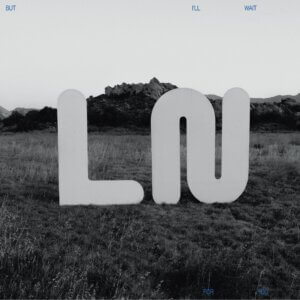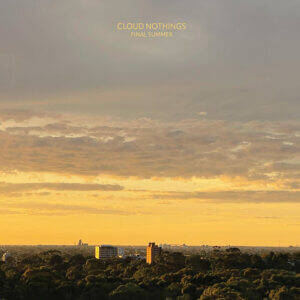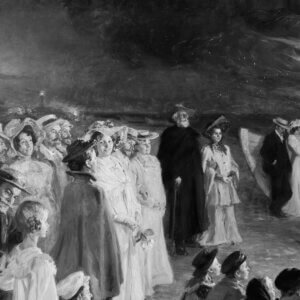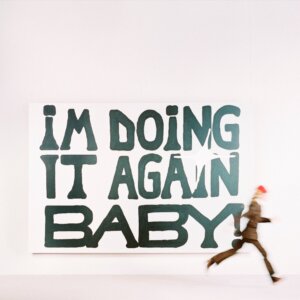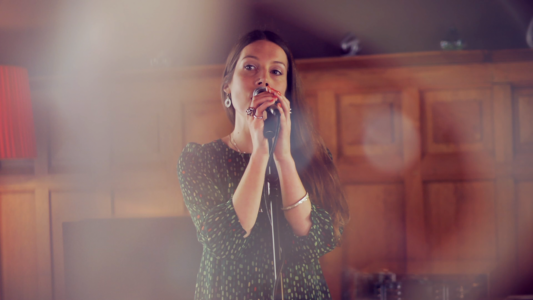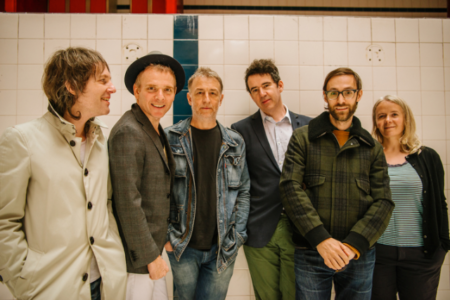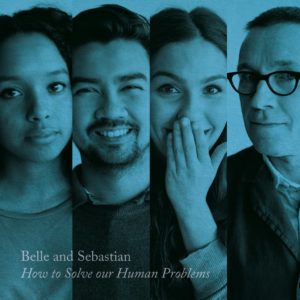Interview With Stuart Murdoch
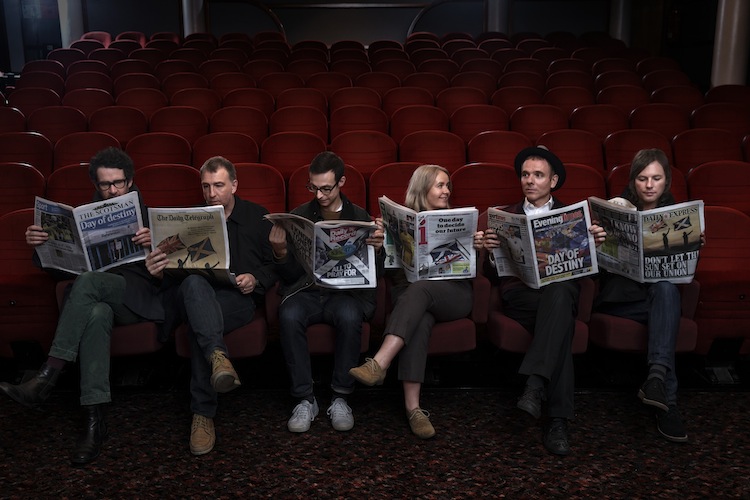
Who would have thought that the bookish, ‘60s indebted Belle and Sebastian would still be around close to two full decades later? Not Stuart Murdoch, who originally projected one or two records from the project when he formed the group in 1996. Those records that came to be, Tigermilk and If You’re Feeling Sinister, would become landmark indie releases, but rather than repeat its formula, the band has always kept a foot forward, going where the muse leads them. It is particularly great to be in 2015 and find that she has lead the group to their best record since the The Boy with the Arab Strap, with the gorgeously ornate and ever-alive Girls in Peacetime Want to Dance. Produced by Ben H. Allen, the record is an hour of lush, elastic ear candy. The songwriting is sharper than ever, still finding new ways to branch out in ways that fit the group’s eccentricities. There are funky songs, ‘80s-style synth pop, gospel-tinged backing vocals, glistening orchestration, and a pocket novel’s worth of slap-you-in-the-face lyrics.
Talking to frontman Stuart Murdoch, it’s great to hear that churning out songs is still such a fun exercise for the band. They are a group that is in complete awe of the pop song, yet is also never intimidated by it. Now 46, it’s clear that Stuart’s muse is indeed everlasting, as is the subject of one of the album’s many highlights
Check out our chat, and do check out Girls in Peacetime Want to Dance, which is out January 19 on Matador.
Northern Transmissions: When did you start working on Girls in Peacetime Want to Dance?
Stuart Murdoch: As soon as we started editing the film [God Help the Girl] which was in 2013, the band when out and played some shows over the summer and then in September we started writing the record.
NT: You guys write all the songs together?
SM: It’s a mixture of things – some of the songs I bring in fully formed, or Sarah [Martin] brings in fully formed, and some of them get written in the room. Some of them are a clash of different things that people bring in. A notable example being “Perfect Couples,” which Chris [Geddes] started off with a kind of African-style groove, and then Stevie [Jackson] recognized that he had a song that could work with that.
NT: I had read that “Ever Had a Little Faith” was actually a very old song.
SM: Oh, yeah that was an older song. It was a very straightforward song because it hearkened back to the original style that the group were playing. Everybody was playing their primary instruments. It really came together in about half an hour. That one was a nice one to do. We ran it a couple of times and then just left it for the studio because we didn’t want to ruin it.
NT: The record is great because it’s super diverse – but it still flows very well. Are there certain frames of reference for songs that you were drawing from that you haven’t before in the past? “The Everlasting Muse” in particular has a sound that almost reminds me of Balkan folk music.
SM: Sure, I mean I don’t really think in terms of frame of reference, because the song almost just rolled out. The first part of the song was a direct evocation of the muse. I was trying to write a song to the muse so that she would provide me with more songs, because it was the first song I wrote for the record. So I had the tune for that which is [sings the melody of the verse in da-das], which I always thought I could heard the standup bass with, like [sings bass line in dum-dums], so that’s all you have to know. The surprising thing was the halt in the song. And then it goes into a different rhythm. I don’t really know what it came from. I’m sure it’s an echo of another pop song or some sort of ‘40s or ‘50s dance music, or big band swing or something.
NT: Yeah, I mean musically it has an old world vibe to it. Pre-rock at least. There are certain songs on this record that remind me of ABBA. Do you feel like that makes sense?
SM: Yeah I think it’s possible that something can remind you of ABBA without actually being close to the ABBA sound. I tend to think of the ABBA sound as being just amazing. It’s a very individual thing. You can always recognize ABBA when you hear it. It’s unique. But certainly those tracks, particularly “Enter Sylvia Plath” is in the same ballpark. It’s pretty European.
NT: I read that EuroVision had an influence on some of the songwriting?
SM: Well, I raised that possibility before the album was made I think in an interview with Rolling Stone. And at the time, or at least that week, it was a touchstone for me. I love EuroVison and the possibilities of EuroVision, that Europe gets together once a year for a cultural exchange.
NT: Not to say that say that there aren’t dance songs in Belle and Sebastian’s history, but this record seems more focused on delivering tracks with a dancey groove more than any other (there are great ballads too, but we’ll get to that). Were you always into music you could dance to even in the group’s early days, or was this something that developed through your years of performing?
SM: Well, I was a DJ from the ‘80s. From ’86 onward and then I started getting burnt out with that. But I still danced a lot throughout the ‘90s, especially when the group got together, we were always out at various clubs on different nights. The dance floor always inspired us and it sort of threw down the gauntlet and challenged us to make dance music.
NT: I feel like your music isn’t known for dancing, but there’s plenty of songs of yours, even from your early years, that I’ll hear when I’m out at clubs. I go a party called Mondo where they regularly play “Electronic Renaissance,” “The Boy With the Arab Strap,” and “Dirty Dream Number Two” a lot.
SM: I think it’s possible to dance to pretty much anything, it’s a sliding scale. When I DJed, later on I played acid house music, but I also played Beat Happening, and the Pastels, and Mudhoney, and the Jam, and the Smiths, which is not traditional dance music, but I think in Britain especially, we like to mix it up.
NT: I think that’s true here in New York, but I’m not sure how it is other places in the US. The song, “The Party Line” might be the most straight-up dance song you’ve made, although that could be debated. That one in particular sounds like something you’d expect from a DFA artist. Is it meant to be political?
SM: It’s mildly political. Bob made up the title and brought it to the band, and we actually thought it was a good title because it dealt with domestic issues and political issues, or just simply a night out. In the end, we made the words mostly about having an adventure on a night out. We didn’t really bring up the political issues, but when we went to make a video ourselves it was going to involve politicians with masks on the dance floor, but then it got taken over by someone else.
NT: On the subject of writing different types of songs, do you ever find yourself writing a song and discarding it because you don’t feel it fits the group?
SM: Well, I like it! I like it when we reach a situation when it’s like, “this isn’t really us.” In fact, I don’t think we’ve ever said it full-stop. The only time I ever wrote a song and said, “Well, this isn’t really for the band,” was all the film songs because I specifically heard the female singing it, and I knew it was a female character. I could have sang all the film songs. I mean a song is a song. But as long as I’m singing it and the guys are playing it, it’s still going to sound a little bit like Belle & Sebastian.
NT: There’s a lot of this album I love, but I think I’m into the last song, “Today (This Army is For Peace)” the best. It’s a really great, serene song.
SM: Yeah, that was another song I didn’t want to work too hard on, because it was very simple musically. It was just about creating an atmosphere in the room, so we tried taking the atmosphere to Atlanta [where the record was recorded], and the song itself is based on a dream, like waking from a dream. The first breath is very dream-like. Perhaps seeing a vision of paradise, or a small picture of another world and then waking up and being back on Earth. It’s almost like trying to put a full-stop on the rest of the songs on the album, looking at turmoil, and hints of war, and looking at the political situation, etc. And coming back and being like, “Yeah, we may talk about these things, but we’re for peace, and we don’t want to forget that.”
NT: It caps the album extremely well. I love the mellotron part on it – the only other time I think I’ve heard that instrument on any of your others songs was on “Beyond the Sunrise” off Fold Your Hands Child, You Walk Like a Peasant.
SM: Yeah, it is a mellotron, a mellotron sample. I loved it too, but I had to fight the producer. It was one of our major battles. He didn’t want it at all. He had said that the melltron had been done so often. I agreed with him, but it was so suitable. I [couldn’t] imagine this song without it. So we fought about it, and I actually had to say, “If I can’t use the mellotron, then this song won’t go on the record.” I had to plant the A-bomb there.
NT: It’s funny that was an issue. I would agree that the mellotron did get sort of played out by the mid ‘00s, but I feel like it hasn’t been prevalent in a bit. I feel it’s a good time to bring it back, if only sparingly here and there.
How did you come to titling the record?
SM: It was just a phrase I wrote down one day. I write many things down and some of them turn into songs, some of them get forgotten. I thought maybe it would be a song but when I thought about the artwork, I realized it was a perfect title. I thought about it for ten seconds and then didn’t think about it again.
NT: How do album titles usually happen for Belle & Sebastian?
SM: Usually the title is the last thing, because it feels like it needs to be the frame on the picture. Sometimes I have a title in advance. For instance, the LP which eventually would be called The Life Pursuit, was meant to be called Rest and Be Thankful. And I took the pictures for the album shoot with that title in mind, because Rest and Be Thankful is a Scottish tourist attraction, at the top of a very steep hill, where you’re supposed to stop and look at the view and rest and be thankful. I had this big plan, I had the perfect picture for it. And then somebody in the band didn’t like the title and they said it sounded like we were stopping, so I changed the title, but I still think the original title was better.
NT: Yeah, I mean I guess I could see how it would have sounded like a swan song sort of title. Speaking of the band not stopping, you guys are closing in on your 20th year as a band. What would you say is the secret to your longevity?
SM: Well, I could talk about staying friends with everybody, and making sure everyone can make a living from the music which is so important, but seriously, the main thing is the flow of songs, the flow of music. If the music isn’t fresh, if you don’t feel inclined to do it, if you’re not excited about bringing songs into the group, then it’s over. It should be over. Then you turn into the Eagles and you might as well do comeback tours.
Douglas Bleggi
Latest Reviews
Tracks
Advertisement
Looking for something new to listen to?
Sign up to our all-new newsletter for top-notch reviews, news, videos and playlists.

